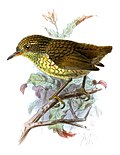Movement
The crowned slaty flycatcher is a partial migrant. Subspecies E. a. pallideventris is a year-round resident. The nominate subspecies breeds in the area roughly south of a line from east-central Bolivia east to eastern Mato Grosso do Sul in Brazil and vacates that area for the austral winter. That population regularly migrates north into northern Bolivia and Amazonian Brazil, Peru, Ecuador, and southeastern Colombia. The nominate subspecies is a year-round resident in west-central Brazil between its breeding-only and wintering ranges. [8] There are very few records in Venezuela. [12] It fairly regularly reaches Guyana but is known in French Guiana and Chile only as a vagrant. [9] In addition there are a few records west of the Andes in Ecuador [13] and the abovementioned single records in Panama and Louisiana. [10] [11]
During the breeding season the crowned slaty flycatcher inhabits a variety of somewhat open landscapes including deciduous and gallery forest, light woodlands, scrublands, and cerrado with scattered trees. Birds wintering in the Amazon Basin primarily inhabit the canopy on the edge of forest and openings and clearings within it. While wintering there they occur in both varzea and terra firme forest. [8] In elevation the species is found in Brazil mostly from sea level to 1,200 m (3,900 ft) and occasionally higher. [14] It reaches 1,200 m (3,900 ft) in Colombia, 1,100 m (3,600 ft) in Ecuador, and 1,000 m (3,300 ft) in Peru. [15] [13] [16] The confirmed records in Venezuela were at elevations of about 250 m (800 ft) though there is a sight record at 2,500 m (8,200 ft). [12]




